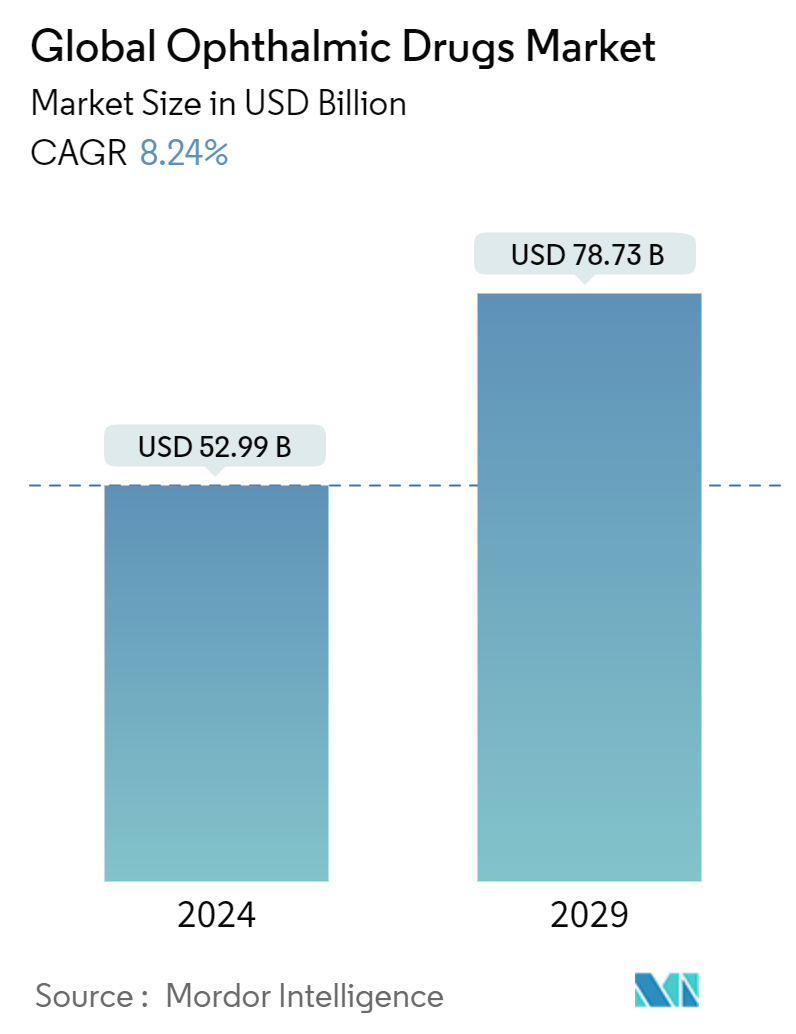Market Size of Global Ophthalmic Drugs Industry

| Study Period | 2019 - 2029 |
| Market Size (2024) | USD 52.99 Billion |
| Market Size (2029) | USD 78.73 Billion |
| CAGR (2024 - 2029) | 8.24 % |
| Fastest Growing Market | Asia-Pacific |
| Largest Market | North America |
Major Players
*Disclaimer: Major Players sorted in no particular order |
Need a report that reflects how COVID-19 has impacted this market and its growth?
Ophthalmic Drugs Market Analysis
The Global Ophthalmic Drugs Market size is estimated at USD 52.99 billion in 2024, and is expected to reach USD 78.73 billion by 2029, at a CAGR of 8.24% during the forecast period (2024-2029).
The Global Ophthalmic Drugs Market is witnessing significant growth, underpinned by various factors driving both innovation and expansion in the industry. Key drivers include the increasing prevalence of eye-related disorders and advancements in drug development technologies, which are reshaping the market landscape.
Megatrends Shaping the Industry: The global rise in ocular conditions, an aging population, and advancements in drug formulation technologies are creating robust foundations for growth. These factors, along with specific industry drivers, are pushing the ophthalmic drugs market to new heights.
Increasing Incidence and Prevalence of Eye-related Disorders: The growing number of individuals with vision impairment is a major factor driving the ophthalmic drugs market. According to the World Health Organization, over 2.2 billion people globally suffer from vision-related issues, with at least 1 billion cases preventable. This population is impacted by conditions such as cataracts, refractive errors, glaucoma, and diabetic retinopathy. The high burden of these diseases underscores the urgent need for new and effective ophthalmic treatments, driving the market forward.
Rising Research and Development Pertaining to the Development of Novel Drugs: The ophthalmic drugs market is benefiting from increased R&D activity aimed at creating novel therapeutic solutions. The rise in clinical trials and drug approvals highlights this trend. In 2023, the FDA accepted a New Drug Application for CyclASol, a novel anti-inflammatory product for dry eye disease. Similarly, the European launch of a ranibizumab biosimilar by Xbrane Biopharma AB and STADA Arzneimittel AG showcases the surge in cost-effective treatment options. These innovative drugs are expanding the therapeutic landscape and boosting market growth.
Increasing Focus on Developing Combination Therapies: The emphasis on combination therapies within the ophthalmic drugs market is growing. These treatments offer superior therapeutic results for managing complex ocular diseases. For instance, Visus Therapeutics Inc. collaborated with Cella Therapeutics to develop a range of ophthalmic therapies targeting glaucoma and age-related macular degeneration. Such partnerships are fueling innovation in the field, accelerating market expansion by addressing unmet medical needs.
The Global Ophthalmic Drugs Market is on a steady growth trajectory, driven by these trends and developments. Future advancements in drug innovation, personalized treatments, and increased access to eye care will continue to shape the industry. As public awareness around eye health rises and early intervention becomes more critical, the market is poised for sustained growth.
Ophthalmic Drugs Industry Segmentation
As per the scope of the report, ophthalmic drugs are used to treat various disorders associated with the eyes, such as glaucoma, cataracts, and diabetic retinopathy, to name a few. The ophthalmic drugs market is segmented by drug class, product type, and geography. By drug class, the market is segmented into anti-glaucoma drugs, dry eye drugs, ophthalmic anti-allergy/inflammatory, retinal drugs, anti-infective drugs, and other drugs. By product type, the market is segmented into OTC drugs and prescription drugs. By geography, the market is segmented into North America, Europe, Asia-Pacific, Middle East, and Africa, and South America. The market report also covers the estimated market sizes and trends for 17 countries across major global regions. The report offers the value (in USD) for the above segments.
| By Drug Class | |
| Anti-glaucoma Drugs | |
| Dry Eye Drugs | |
| Ophthalmic Anti-allergy/Inflammatory | |
| Retinal Drugs | |
| Anti-infective Drugs | |
| Other Drugs |
| By Product Type | |
| OTC Drugs | |
| Prescription Drugs |
| Geography | ||||||||
| ||||||||
| ||||||||
| ||||||||
| ||||||||
|
Global Ophthalmic Drugs Market Size Summary
The ophthalmic drugs market is poised for significant growth over the forecast period, driven by an increasing prevalence of eye-related disorders such as glaucoma and dry eye disease. The market's expansion is further supported by advancements in research and development, focusing on novel and combination therapies. The COVID-19 pandemic initially disrupted the market by affecting outpatient numbers and altering diagnosis distributions, but the resumption of treatment services and increased hospital visits are expected to boost demand for ophthalmic drugs. The market is characterized by a competitive landscape with both small and large firms, with major players like Aerie Pharmaceuticals, AbbVie, and Novartis AG leading the charge in innovation and product development.
Regionally, Asia-Pacific is anticipated to experience the fastest growth due to its large geriatric population and high prevalence of eye disorders. The region's market growth is further fueled by the presence of key industry players and a rising focus on research and development activities. The anti-glaucoma drug segment is expected to hold a significant market share, driven by the increasing burden of glaucoma and the aging population. Despite challenges such as the loss of patent protection for popular drugs and limited health insurance coverage in developing countries, the ophthalmic drugs market is set to expand, with ongoing product launches and strategic business activities like mergers and acquisitions enhancing market dynamics.
Global Ophthalmic Drugs Market Size - Table of Contents
-
1. MARKET DYNAMICS
-
1.1 Market Overview
-
1.2 Market Drivers
-
1.2.1 Increasing Incidence and Prevalence of Eye-related Disorders
-
1.2.2 Rising Research and Development Pertaining to the Development of Novel Drugs
-
1.2.3 Increasing Focus on Developing Combination Therapies
-
-
1.3 Market Restraints
-
1.3.1 Loss of Patent Protection for Popular Drugs
-
1.3.2 Lack of Health Insurance in the Developing Countries
-
-
1.4 Porter's Five Forces Analysis
-
1.4.1 Threat of New Entrants
-
1.4.2 Bargaining Power of Buyers/Consumers
-
1.4.3 Bargaining Power of Suppliers
-
1.4.4 Threat of Substitute Products
-
1.4.5 Intensity of Competitive Rivalry
-
-
-
2. MARKET SEGMENTATION (Market Size by Value- USD)
-
2.1 By Drug Class
-
2.1.1 Anti-glaucoma Drugs
-
2.1.2 Dry Eye Drugs
-
2.1.3 Ophthalmic Anti-allergy/Inflammatory
-
2.1.4 Retinal Drugs
-
2.1.5 Anti-infective Drugs
-
2.1.6 Other Drugs
-
-
2.2 By Product Type
-
2.2.1 OTC Drugs
-
2.2.2 Prescription Drugs
-
-
2.3 Geography
-
2.3.1 North America
-
2.3.1.1 United States
-
2.3.1.2 Canada
-
2.3.1.3 Mexico
-
-
2.3.2 Europe
-
2.3.2.1 Germany
-
2.3.2.2 United Kingdom
-
2.3.2.3 France
-
2.3.2.4 Italy
-
2.3.2.5 Spain
-
2.3.2.6 Rest of Europe
-
-
2.3.3 Asia-Pacific
-
2.3.3.1 China
-
2.3.3.2 Japan
-
2.3.3.3 India
-
2.3.3.4 Australia
-
2.3.3.5 South Korea
-
2.3.3.6 Rest of Asia-Pacific
-
-
2.3.4 Middle East and Africa
-
2.3.4.1 GCC
-
2.3.4.2 South Africa
-
2.3.4.3 Rest of Middle East and Africa
-
-
2.3.5 South America
-
2.3.5.1 Brazil
-
2.3.5.2 Argentina
-
2.3.5.3 Rest of South America
-
-
-
Global Ophthalmic Drugs Market Size FAQs
How big is the Global Ophthalmic Drugs Market?
The Global Ophthalmic Drugs Market size is expected to reach USD 52.99 billion in 2024 and grow at a CAGR of 8.24% to reach USD 78.73 billion by 2029.
What is the current Global Ophthalmic Drugs Market size?
In 2024, the Global Ophthalmic Drugs Market size is expected to reach USD 52.99 billion.

